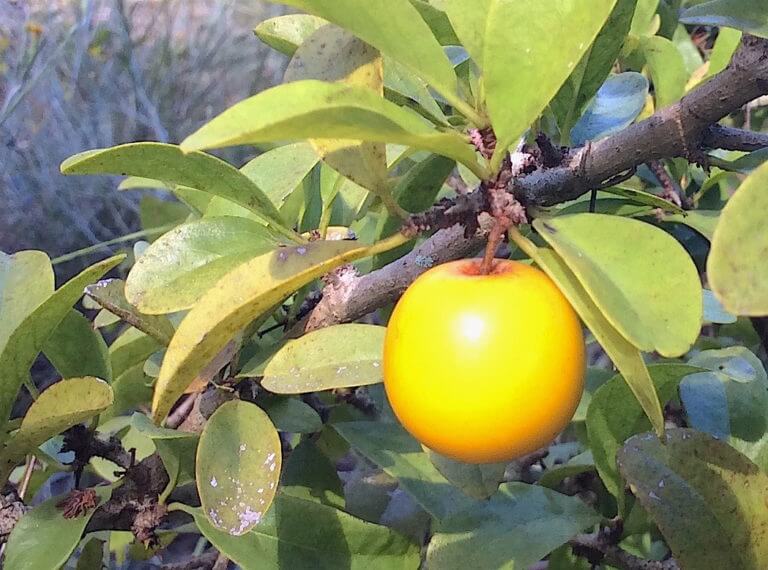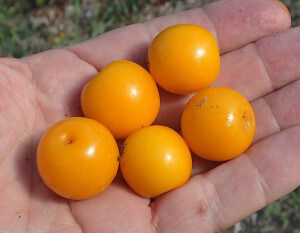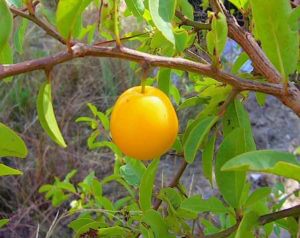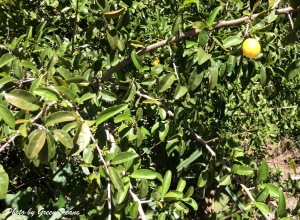Ximenia americana: Known by Many Names
If I listed this edible under its botanical name few would find it. On the other hand it has some three dozen commons names in several languages. So which one does one choose? In English, Tallow Plum is the most accurate.
It has also been called the American plum, blue sour plum, monkey plum, mountain plum, seaside plum, Spanish plum, wild plum, hog plum, and yellow plum though it is not a plum but its leaves can be bluish. Other names include pepenance, coastal prune, spiny prune, Brazilian apricot, spiny apricot, wild apricot, little apricot and little wild apricot though it is not a prune nor an apricot. Then there is ocean cherry, wild cherry and cherry — no, it is not a cherry either; sea lemon, seaside lemon, wild orange, and wild lime…and no it is not a citrus. Others prefer devil’s apple, fiddle apple, little apple and wild quince. Yes, you guessed it again: It is not an apple or any apple relative. Some even call it the Wild Olive. No, it is not related to the olive but it is in the Olax family. Olive/olax… tenuous at best. There is also a darker side with names like purge-nut, cagalera (diarrhea) and fransman moppe (Frenchman’s complaint) a reference to what too many of the seeds can do.
It got the name Tallow Plum because of the waxy texture of the fruit. Botanically it is Ximenia americana (that’s hem-MAY-nee-uh a-mer-ih-KAY-na.) It was named for the Spanish monk Francisco Ximenez, a native of Luna in the Kingdom of Aragon. Americana means of the Americas. It is an important food source in Ethiopia and Brazil.
Found in Florida and south, locally it likes dry scrub areas. The picture above came from the southwest side of the entrance road to Haulover Canal parking lot on the north end of Kennedy Space Center. Tallow Plums here in Florida range from a few feet tall to sprawling shrubs five or six feet tall. In southern hammocks, however, which are islands of hardwoods in wet areas, it can grow to 35 feet.
The yellow fruit, sometimes orange/red particularly when dropped off the tree, is edible raw or cooked. It can range from a bitter-almond in flavor to sweet. The flesh is somewhat astringent and sticky. There is no particular aroma of the fruit but the flowers have an intense lilac aroma. Young leaves, which have a strong aroma of almonds, can also be well-boiled then eaten in small amounts. Think famine food. Do not eat them raw. They contain hydrocyanide.
The oil of the seed is also edible and used for cooking. It has 10 fatty acids, seven unsaturated yielding a total unsaturation of 92.42%. The oil contained essential fatty acids of Linoleic (1.34%), Linolenic (10.31%), Arachidonic (0.60%) and varying levels of unsaturated higher fatty acids, specifically Eicosatrienoic (3.39%), Erucic (3.46%) and Nervonic (1.23%) acids. The level of Oleic acid is 72.09%. the fruit has chigh levels of vitamin C (160,26 mg per100 g), yellow flavonoids (43,12 mg per100 g), total extractable polyphenols (3066,48 mg per 100 g) and antioxidant activity (365,55 g fruit/g DPPH e 251,70 μmol Trolox/g.
The pulp of the seed itself is purgative raw, and is used as a seasoning. A few can be eaten after cooking but if too many cooked ones are consumed, like the raw ones, they becomes a most efficient laxative. The fruit is known to quench thirst, is used as a drink and in making jams and jellies. In Tazania the Sandawe (Bushmen) rely on the fruit as a staple. The seed oil is use for skin moisturizing and as of this writing is commercially available costing $5 and ounce, not counting shipping.
Addendum March 2018: A strapping, young, adult male reported to me that he ate about 20 Gopher Apples and 10 Tallow Plums at one sitting. They gave him temporary premature ventricular contractions which he verified by a heart monitor. And they went away in a short while. Thus we don’t which fruit might have caused said, or a combination of them, the amount, or if it was a personal sensitivity or something else entirely.
Green Deane’s “Itemized” Plant Profile
IDENTIFICATION: A shrub to a small tree, branches long, zig-zaggy, vine-like, semi-climbing, thorny; leaves alternate, yellowish-green in the scrub, darker green in hammocks, oblong or elliptic, rounded or notched at the apex, or spine tipped, one to three inches long, some times in clusters of three. Flowers yellowish, four petals, 3/8 inch wide, hairy within, very fragrant, similar to lilac, in small clusters. Fruit a broad oval or nearly round, to 1.5 inches long, skin smooth, bright yellow to orange red, flesh yellow, bitter almond to sweet flavor, sub acid to acid. Seed large, oval, buff-colored with white nut like kernel. The wood is very dense and the plant can be parasitic.
TIME OF YEAR: Spring and fall
ENVIRONMENT: Dry scrub lands to hardwood hammocks. For several decades I only found them in coastal areas. But this past year I found one under a pine west of Orlando, mid-state.
METHOD OF PREPARATION: Fruit edible raw or cooked, used for juice, jelly, jam and wine. Kernel roasted but in limited quantities, seed oil is edible and can also be used in making soap, lubrication and a vegetable butter. Young leaves can be boiled and eaten sparingly. Raw fruit picked when unripe. The fruit is high in Vitamin C and oil that has been used externally on hair and as a skin softener.
HERB BLURB
The bark, fruit, and leaves have several medicinal uses. Leaves and twigs are used to treat fever, colds, as a laxative and an eye lotion. Leaves are used for headaches, angina, and a poison antidote. Roots are used for skin problems, headaches, venereal disease, sleeping sickness, and water retention. The fruit has been used for constipation. The bark has been used for febrile headaches, bath water for sick children, for kidney and heart complaints, and applied to skin ulcers. Stem bark methanolic and water extracts of showed a spectrum of activity against E coli, P. vulgaris, S. aureus, P. aeruginosa and B. subtilis.





